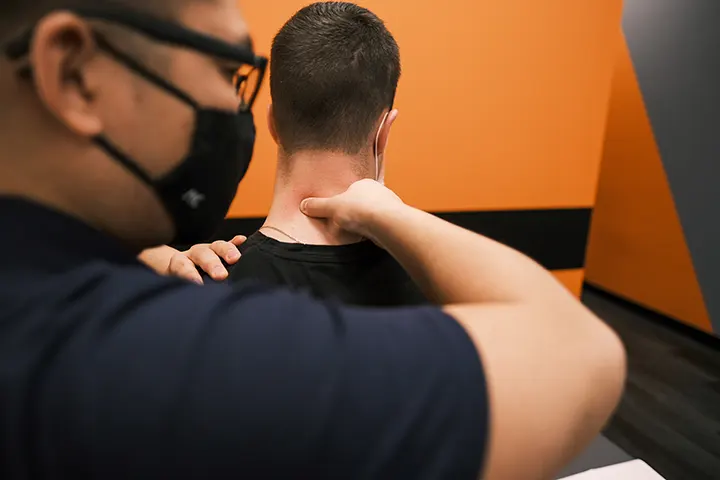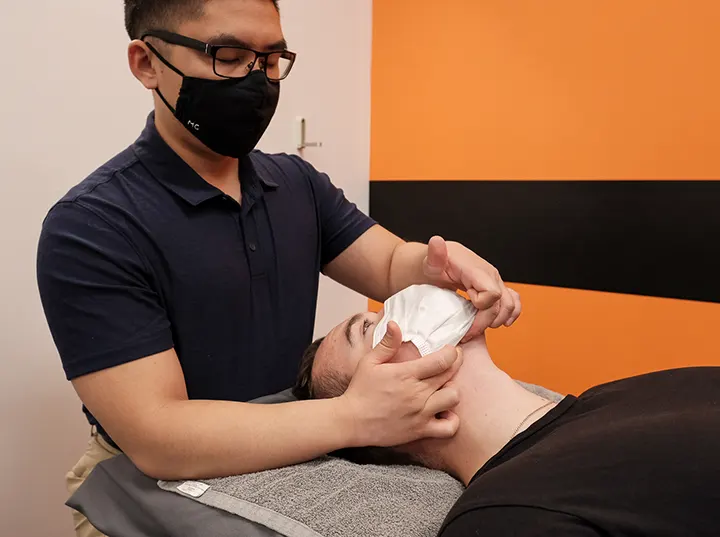Registered Massage Therapist
A registered massage therapist (RMT) is a healthcare professional who specializes in providing therapeutic massage treatments to address various physical and musculoskeletal issues. Their primary goal is to promote healing, relaxation, and overall well-being for their clients through the application of manual techniques.
Assessment and Evaluation
RMTs begin by assessing the client's health history, current physical condition, and any specific concerns or areas of discomfort. This assessment helps them tailor the massage treatment to the client's individual needs.
Treatment Planning
Based on the assessment, the RMT develops a personalized treatment plan that may include specific massage techniques, areas to focus on, and the number of sessions required to achieve the desired outcomes.
Massage Techniques
RMTs are trained in a variety of massage techniques, such as Swedish massage, deep tissue massage, myofascial release, trigger point therapy, sports massage, and more. They apply these techniques using their hands, fingers, elbows, and sometimes even specialized tools to manipulate muscles, soft tissues, and joints.


Pain Relief and Rehabilitation
Registered massage therapists often work with clients who are experiencing pain, tension, or discomfort due to injuries, chronic conditions, or repetitive strain. They use massage to alleviate pain, improve circulation, reduce muscle tension, and enhance range of motion.
Relaxation and Stress Reduction
In addition to treating specific physical issues, RMTs also provide relaxation massages that help clients unwind, reduce stress, and promote a sense of relaxation and tranquility.
Education and Self-Care
RMTs often educate their clients about proper posture, stretching exercises, and other self-care techniques that can complement the benefits of massage therapy and promote long-term wellness.
Client Communication
Effective communication is essential in the massage therapy process. RMTs listen to their clients' concerns, answer questions, and adapt their techniques based on client feedback.
Maintaining Ethical Standards
Registered massage therapists adhere to a strict code of ethics and professional conduct, ensuring that they provide safe, confidential, and respectful treatments.
Documentation
RMTs may keep records of their clients' assessments, treatment plans, and progress to track improvements over time and ensure continuity of care.
Continuing Education
The field of massage therapy is constantly evolving, and RMTs often engage in ongoing education to stay updated on the latest techniques, research, and best practices.

Registered Massage Therapist
A registered massage therapist (RMT) is a healthcare professional who specializes in providing therapeutic massage treatments to address various physical and musculoskeletal issues. Their primary goal is to promote healing, relaxation, and overall well-being for their clients through the application of manual techniques.

Assessment and Evaluation
RMTs begin by assessing the client's health history, current physical condition, and any specific concerns or areas of discomfort. This assessment helps them tailor the massage treatment to the client's individual needs.
Treatment Planning
Based on the assessment, the RMT develops a personalized treatment plan that may include specific massage techniques, areas to focus on, and the number of sessions required to achieve the desired outcomes.
Massage Techniques
RMTs are trained in a variety of massage techniques, such as Swedish massage, deep tissue massage, myofascial release, trigger point therapy, sports massage, and more. They apply these techniques using their hands, fingers, elbows, and sometimes even specialized tools to manipulate muscles, soft tissues, and joints.

Pain Relief and Rehabilitation
Registered massage therapists often work with clients who are experiencing pain, tension, or discomfort due to injuries, chronic conditions, or repetitive strain. They use massage to alleviate pain, improve circulation, reduce muscle tension, and enhance range of motion.
Relaxation and Stress Reduction
In addition to treating specific physical issues, RMTs also provide relaxation massages that help clients unwind, reduce stress, and promote a sense of relaxation and tranquility.
Education and Self-Care
RMTs often educate their clients about proper posture, stretching exercises, and other self-care techniques that can complement the benefits of massage therapy and promote long-term wellness.

Client Communication
Effective communication is essential in the massage therapy process. RMTs listen to their clients' concerns, answer questions, and adapt their techniques based on client feedback.
Maintaining Ethical Standards
Registered massage therapists adhere to a strict code of ethics and professional conduct, ensuring that they provide safe, confidential, and respectful treatments.
Documentation
RMTs may keep records of their clients' assessments, treatment plans, and progress to track improvements over time and ensure continuity of care.
Continuing Education
The field of massage therapy is constantly evolving, and RMTs often engage in ongoing education to stay updated on the latest techniques, research, and best practices.
Registered Massage Therapist
A registered massage therapist (RMT) is a healthcare professional who specializes in providing therapeutic massage treatments to address various physical and musculoskeletal issues. Their primary goal is to promote healing, relaxation, and overall well-being for their clients through the application of manual techniques.

Assessment and Evaluation
RMTs begin by assessing the client's health history, current physical condition, and any specific concerns or areas of discomfort. This assessment helps them tailor the massage treatment to the client's individual needs.
Treatment Planning
Based on the assessment, the RMT develops a personalized treatment plan that may include specific massage techniques, areas to focus on, and the number of sessions required to achieve the desired outcomes.
Massage Techniques
RMTs are trained in a variety of massage techniques, such as Swedish massage, deep tissue massage, myofascial release, trigger point therapy, sports massage, and more. They apply these techniques using their hands, fingers, elbows, and sometimes even specialized tools to manipulate muscles, soft tissues, and joints.

Pain Relief and Rehabilitation
Registered massage therapists often work with clients who are experiencing pain, tension, or discomfort due to injuries, chronic conditions, or repetitive strain. They use massage to alleviate pain, improve circulation, reduce muscle tension, and enhance range of motion.
Relaxation and Stress Reduction
In addition to treating specific physical issues, RMTs also provide relaxation massages that help clients unwind, reduce stress, and promote a sense of relaxation and tranquility.
Education and Self-Care
RMTs often educate their clients about proper posture, stretching exercises, and other self-care techniques that can complement the benefits of massage therapy and promote long-term wellness.

Client Communication
Effective communication is essential in the massage therapy process. RMTs listen to their clients' concerns, answer questions, and adapt their techniques based on client feedback.
Maintaining Ethical Standards
Registered massage therapists adhere to a strict code of ethics and professional conduct, ensuring that they provide safe, confidential, and respectful treatments.
Documentation
RMTs may keep records of their clients' assessments, treatment plans, and progress to track improvements over time and ensure continuity of care.
Continuing Education
The field of massage therapy is constantly evolving, and RMTs often engage in ongoing education to stay updated on the latest techniques, research, and best practices.
Registered Massage Therapist
A registered massage therapist (RMT) is a healthcare professional who specializes in providing therapeutic massage treatments to address various physical and musculoskeletal issues. Their primary goal is to promote healing, relaxation, and overall well-being for their clients through the application of manual techniques.

Assessment and Evaluation
RMTs begin by assessing the client's health history, current physical condition, and any specific concerns or areas of discomfort. This assessment helps them tailor the massage treatment to the client's individual needs.
Treatment Planning
Based on the assessment, the RMT develops a personalized treatment plan that may include specific massage techniques, areas to focus on, and the number of sessions required to achieve the desired outcomes.
Massage Techniques
RMTs are trained in a variety of massage techniques, such as Swedish massage, deep tissue massage, myofascial release, trigger point therapy, sports massage, and more. They apply these techniques using their hands, fingers, elbows, and sometimes even specialized tools to manipulate muscles, soft tissues, and joints.

Pain Relief and Rehabilitation
Registered massage therapists often work with clients who are experiencing pain, tension, or discomfort due to injuries, chronic conditions, or repetitive strain. They use massage to alleviate pain, improve circulation, reduce muscle tension, and enhance range of motion.
Relaxation and Stress Reduction
In addition to treating specific physical issues, RMTs also provide relaxation massages that help clients unwind, reduce stress, and promote a sense of relaxation and tranquility.
Education and Self-Care
RMTs often educate their clients about proper posture, stretching exercises, and other self-care techniques that can complement the benefits of massage therapy and promote long-term wellness.

Client Communication
Effective communication is essential in the massage therapy process. RMTs listen to their clients' concerns, answer questions, and adapt their techniques based on client feedback.
Maintaining Ethical Standards
Registered massage therapists adhere to a strict code of ethics and professional conduct, ensuring that they provide safe, confidential, and respectful treatments.
Documentation
RMTs may keep records of their clients' assessments, treatment plans, and progress to track improvements over time and ensure continuity of care.
Continuing Education
The field of massage therapy is constantly evolving, and RMTs often engage in ongoing education to stay updated on the latest techniques, research, and best practices.
© Copyright Evolution Sport Therapy 2022.
Newsletter Signup
Sign up for our newsletter to receive all the latest!
Newsletter Signup
Sign up for our newsletter to receive all the latest!
© Copyright Evolution Sport Therapy 2022.
Newsletter Signup
Sign up for our newsletter to receive all the latest!
© Copyright Evolution Sport Therapy 2022.